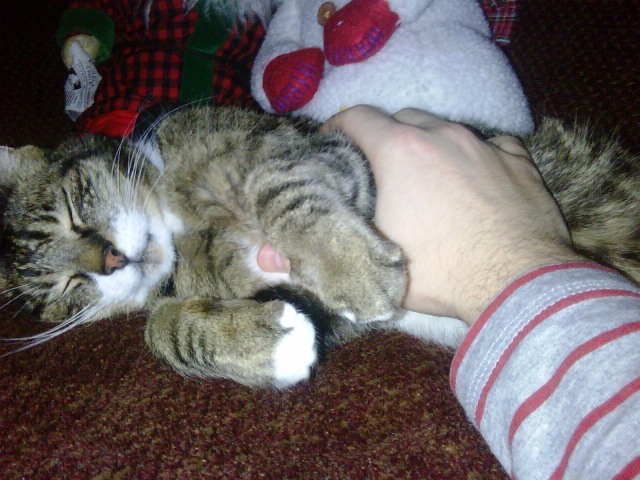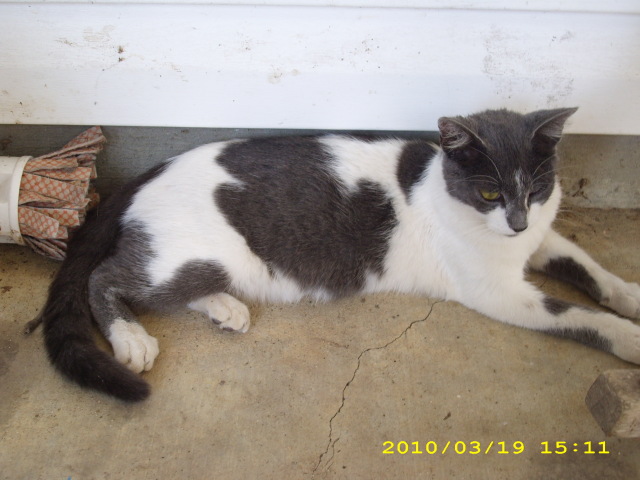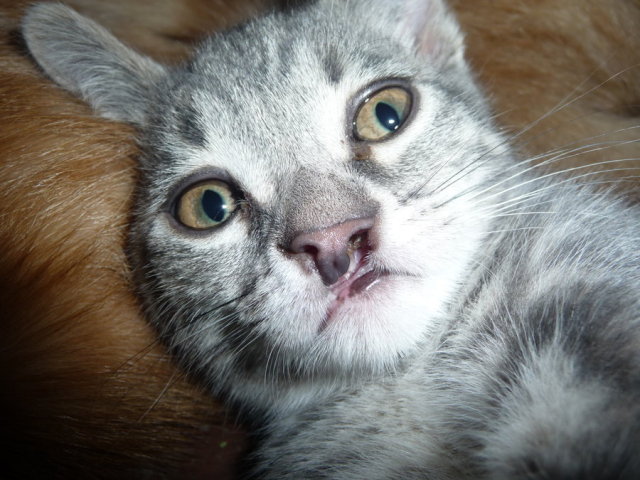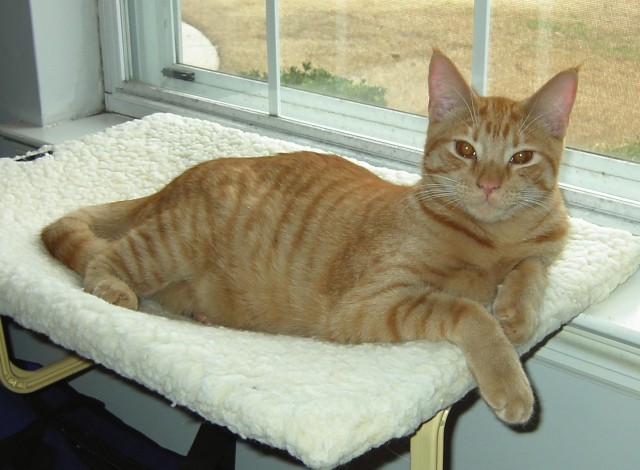QuestionQUESTION: I had sort of gotten the overpopulation of cats by spaying and neutering them. Of course, this was the case with the now grown kittens and the stray moms. But now, what do I do about the feral females who show up on top of my roof? These cats eat and then they disappear. The bad thing is that when it's time to have a litter, they find a place under my porch(it is on pier and beam). And if we cover under the porch, I'm afraid that some of the cats will be trapped and die as well as when it's time for shelter,etc. Is there a suggestion on how to stop this growing number of cats? Also, some of the stray cats will go up the roof and be together with the feral ones, so when it's feeding time, I can't feed only the stray ones because the feral ones will fight for the food and win. Please give me some tips on how to do this? Do you think that if we cover under the porch there will be fewer cats showing up and thus alleviate the problem? I am willing to try anything.
ANSWER: Esther,
Controlling the population of a feral cat colony can be done by practicing a TNR or trap, neuter, release program. You can use a humane live trap baited with tuna or something equally as interesting to hungry feral kitties. Humane live traps can often be borrowed from vet clinics, animal shelters and feral rescue groups like Alley Cat Allies. The important thing when it comes to controlling the feral cat population is to make sure that you spay/neuter as many members of the colony as possible. You will need to find a vet willing to work with these feral kitties, due to the difficulty of handling a feral cat not all vets will take this challenge on. Alley Cat Allies would be a great organization to contact as they can help you out with getting this colony under control.
Obviously you're a kind person concerned with the welfare of the stray cats in your area and it's great that you're making the effort to care for them. Sadly the feral cats are descendants of stray and abandoned cats and their need for help is at least as great as the needs of the strays, possibly even more so. Sadly many people view stray and feral cats as vermin and they go out of their way to hurt or kill these unfortunate souls. I can honestly say that I really don't think there's a way to continue feeding the local strays without feeding the feral colony at the same time. The sad reality is that the feral cats are coming to your feeding station for the same reason that the strays are - they're hungry, they need help and you're offering food and help. It would be best for you to consider setting up more than one area on your property to feed the stray and feral cats if you plan to continue feeding the strays, this will mean that there's less competition for food and of course less fighting over who gets to eat. Unfortunately there's a good chance that the stray cats are simply the newest members of the stray colony, often times abandoned cats will find their place in a colony as it's easier to survive when the cats live together.
It sounds to me like the stray and feral cats are using your porch as a shelter. Homeless cats need shelter to be protected from the elements and larger animals. I'm not sure that blocking off access to the area under your porch will accomplish much, there will simply be more cats squeezed into other nooks and crannies on your property. If you do decide to stop any of the cats from going underneath the porch it's important to ensure that there aren't any newborn kittens, sick adult cats or elderly kitties using this area for shelter. It's probably best to implement a spay/neuter program ASAP to reduce the numbers of kittens to be born this spring. By getting all members of the colony sterilized the cat numbers will gradually decrease over the space of a few years. The average life span for an outdoor cat is roughly 2 years, this is significantly less than the average life span of a well cared for indoor cat, they can live to be 20+ years old. Once you've found a vet willing to spay/neuter these ferals the fighting will settle down. Many of the fights you're seeing are probably due to territorial aggression in addition to only having a single feeding station. Once the sexually mature cats are sterilized it will take a few weeks for the hormone levels to drop, but once that happens the cats will be much happier. It's best to try and spay/neuter kittens as young as possible, in fact there's a good chance you can tame feral kittens under 10 weeks old fairly easily. Once the kittens are tame they can be adopted into loving forever homes.
---------- FOLLOW-UP ----------
QUESTION: All of your advice is very helpful, but when, where, and how should I set the trap to have the feral and stray cats spayed and neutered? I get very nervous and don't know how to do it. Would it be best to do it at night or in the morning or when? And how do I set it up and is there a best place to set it up?
AnswerEsther,
I know that initially when you think about helping out a colony of stray and feral cats actually dealing with the things that need to be done can seem overwhelming. It's wonderful to see that you care enough about these cats to give them a chance at happier, healthier lives without allowing a population explosion to happen. Sadly for stray and feral cats many people view them as pests rather than having compassion for their difficult circumstances. I can see that you have amazing intentions and loads of compassion when it comes to helping to humanely control the population of the cat colony in your area. The whole prospect of finding a vet willing to work with stray and feral cats and what's involved with trapping them so that they can receive the basic medical care they need may seem overwhelming, but it's really not that difficult. I'm going to provide you with a fair bit of information that will hopefully help to alleviate some of your anxiety and address some of your concerns.
The first hurtle that you'll have to overcome is to find a vet in your area that's willing to provide care for the stray and feral cats in this long standing colony. Alley Cat Allies is the one organization that will do their best to help you find a vet willing to do this type of work and possibly defray the costs of care for these cats. Alley Cat Allies is an organization dedicated to helping control populations of cat colonies humanely by sterilizing these cats. In cases where there are young kittens or older friendly stray cats these folks may be able to help you find loving permanent homes for these guys. When the cats truly are feral Alley Cat Allies will ensure that they're treated for internal and external parasites, given a rabies vaccine, microchipped, spayed/neutered and made easily identifiable on sight as having been sterilized, this is usually done by removing the tip of one of the cat's ears. Once the cat has recovered from the anesthesia sufficiently feral cats will be released back into their home territory.
Humane live traps can often be borrowed or rented through animal shelters, rescue groups or organizations that specialize in TNR (trap, neuter, vaccinate and release) programs for cat colonies made up of stray and feral cats such as Alley Cat Allies. When I use humane live traps I've found it useful to bait them with especially tempting foods like tuna, sardines or salmon. The important thing about trapping members of a colony that includes stray and feral cats is to treat all of the cats as though they're feral initially. I normally recommend having a large heavy towel or blanket on hand to cover the trap in case you do trap a feral cat who becomes fearful and tries to escape the humane trap. It's also a good idea to have a thick pair of leather gloves so that you are protected from a fearful cat lashing out with their claws and teeth.
Most times you can assess whether a cat is feral or stray after trapping them once they've had a few minutes to settle down in the darkened cage - a feral cat will likely try everything in his/her power to get away from you if you try to handle him/her, a stray cat may show some initial aggression when the trap closes behind him/her, however they should settle within a fairly short period of time (around 1/2 an hour to 45 minutes on average in my experience).
It's important to consider the length of time that the vet wants these cats to do without food or water prior to surgery. In most cases you'll need to withhold food for 12 hours and water for 8+ hours although your vet may have different instructions meant to minimize the stress on any feral cats you bring in.
With stray cats you can do things a bit differently than you would for a feral cat. Once a stray cat settles down after being caught in a humane live trap you should be able to handle them enough to offer food, water and depending on the time of day that you choose to trap the cats some space to move around in an easy to clean room such as a bathroom that's been outfitted with a litter box, food, water and a comfy place to snooze. I believe that it's important to point out that stray cats did have homes at one point, they often end up trying to survive as strays because they are abandoned by their human family for one reason or another. It's been my experience that cats are abandoned for a variety of reasons which sometimes include a lack of understanding what was involved in caring for a cat, some kitty caregivers have the best of intentions in the beginning but they didn't understand the basic medical costs (vaccines, treating internal/external parasites, spaying/neutering) when they agreed to care for the cat as a young kitten. Sometimes cats are abandoned simply because their caregivers don't want to take responsibility for their cat once they grow out of the tiny kitten stage and reach sexual maturity. Male cats will often mark their territory by spraying pungent smelling urine throughout their home. In the case of female cats many people don't realize that when they go into season they can be quite vocal and very loud while trying to advertise their availability to mate. Female cats who aren't dropped off when they first come into season will end up finding their way outside, mating and getting pregnant which sometimes leads to pet parents refusing to take responsibility for their pregnant cat or her babies.
Feral cats are descendants of abandoned strays that were born outside and they haven't been handled by human beings before. In practical terms feral cats are wild animals, they are often very afraid of people and will try to avoid them at any cost. It's quite possible that if you do decide to get help from Alley Cat Allies to put a TNR program into place that you may end up dealing with feral cats here and there. I wouldn't recommend that you try to handle a feral cat in any way. If you do catch a feral cat in your trap it's best to keep the cage covered with a thick blanket or towel and handle the cage as little as possible. In the event that you do catch a feral cat in your trap the idea is to try and minimize the stress for the cat so s/he should be treated carefully and gently while keeping loud noises to a minimum. It's okay to try and soothe a fearful feral with soft words of encouragement although some cats will become more agitated if you talk to them, in cases like this it's best to cover the entire trap and place it in a quiet room that's climate controlled until it's time for the trip to the vet. If you do happen to catch a feral cat I'd recommend against handling the cat unless it's absolutely necessary because if you lack the experience to safely handle a fearful/aggressive cat there's a fairly high risk that you or the cat may be accidentally injured.
Ultimately the time of day that you choose to trap these cats depends upon your schedule, the arrangement that you have with the vet and when you are available to babysit the trap. Humane live traps should never be left baited and unattended for any length of time because trapping cats is stressful, the elements can create more stress that could potentially result in the cat ending up in serious medical distress. Any cat that you trap in a humane live trap needs to be taken out of the elements immediately and kept as stress free as possible. On occasions when I've used live traps I usually stay where I'm out of sight but I can see the trap clearly - you could choose to sit inside your car or you could even sit just inside a large window overlooking the trap so that you can cover the trap immediately in an effort to minimize stress and exposure to the elements so that any cats that you capture to be spayed/neutered stay as healthy as possible.
It's very important that you spend some time talking with local vets so that you can find a veterinarian willing to work with feral cats because not all vets will take on the challenge of dealing with feral cats because there is an increased risk of injury to the cat, the vet and any staff required to handle a feral cat. In some clinics the vets will only provide care for feral cats after hours to minimize the amount of noise in the clinic and the number of staff required to participate in the cat's care. I would encourage you to try and tell a vet willing to provide care for cats in your neighborhood colony as much as you know about individual cats and of course whether or not it's safe to handle any given cat. If a cat is stray but friendly your vet may be willing to care for him/her during regular office hours. Some vets offer special rates for people who take it upon themselves to trap, vaccinate, neuter and release stray and feral cats in order to reduce the population of colonies humanely through sterilization. Since these cats aren't pets and some may look alike I would recommend that you speak with the vet about ways to identify cats that have been spayed or neutered so that you don't accidentally take the same cat in twice. As far as I'm aware Alley Cat Allies generally microchips the cats so that they can be identified as members of an established colony in the event that they end up in shelters or being picked up as DOA after traffic accidents. Many organizations also make a practice of trimming a small portion off of the top of one of the cat's ears so that it's easy for you to identify which cats have been sterilized at a glance.
Sterilizing these cats will help to humanely reduce the population by preventing reproduction, but there are other medical and behavioral benefits to these surgeries. Intact cats are far more territorial than those that have been spayed or neutered which means that they're more likely to use urine or feces to mark their territory and fight to defend their home territory. I've taken the liberty of including a short summary of medical and behavioral benefits to surgical sterilization of cats in a colony.
- Cat fights are usually quite loud and they tend to happen late at night when the cats are more active.
- When cats fight they will bite each other and break the skin which if left untreated can cause an infection that shows up in the form of an abscess. In the case of stray or feral cats they aren't seen by a vet to drain the abscess and take a course of antibiotics in order to keep the infection from becoming a serious problem.
- Cat bites can spread contagious chronic viral infections such as FIV (feline immunodeficiency virus) or feline leukemia between cats. These viral infections are somewhat similar to HIV/AIDS in people, some cats will become very sick and die while others won't show any signs of illness for most of their lives. These infections aren't transmissible to human beings so caring for cats who test positive for these infections doesn't hold any risk for us, however it's important to take all hygienic precautions after caring for an infected cat to avoid spreading these infections to healthy cats.
- Sterilizing cats reduces their risk of developing prostate/breast cancer and mastitis (a painful infection of the mammary glands that sometimes occurs in nursing moms). Cancers directly affecting the reproductive organs (uterus, ovaries, testicles) are prevented by sterilization. The earlier in life that a cat can be sterilized the lower their risks of developing prostate or breast cancers.
- Female cats that haven't been spayed are at risk of developing a potentially fatal uterine infection called pyometra. This infection occurs when a cat's womb becomes severely infected and fills with pus. If left untreated the likelihood of survival is pretty low, sometimes the cat's womb will rupture spreading infection throughout her abdomen other times the infection will eventually overwhelm the cat's body causing a slow and painful death.
- Behavioral benefits to spaying and neutering cats include a reduced urge to use urine/feces to mark their territory, fewer fights related to territory and mating rights, reduced territory size and there's no longer any need to caterwaul and howl to advertise the availability to mate which will make for much quieter nights in your neighborhood.
Maintaining a colony of cats can be emotionally and financially difficult. It requires patience, perseverance and the ability to act in the best interests of each cat in the colony. In some cases you may be the only human being to ever have compassion for these cats and the willingness to do what's necessary to protect the colony as a whole. Many of these cats have either been abandoned for any number of reasons, others were born into a wild and difficult existence where surviving each day intact is an achievement. Regardless of the reasons for abandoning cats and leaving them to survive on their own I feel pretty strongly that such an action is difficult to justify, especially when there are rescue groups and shelters in most areas who have an open door policy if a guardian is no longer able to provide the care that the cat needs. Some shelters even have programs to help defray the cost of basic and preventative medical care as well as treating injuries or illnesses at low or no cost to the cat's caregiver. In the event that you aren't able to work something out with an organization like Alley Cat Allies so that you aren't having to pay for the cost of care when it comes to sterilizing and vaccinating the entire colony of cats I do keep a fairly extensive list of charities and animal welfare organizations that may be willing to offer a helping hand. Due to the sheer volume of organizations on my list it's just not practical to list every organization for every person who needs assistance so if you do require this information you can send a private question that tells me roughly where you're located (the name of the state will often suffice) so that I can send off the names and other information for organizations most likely to help you out in your area. If there's anything you'd like more information about or you have questions that's absolutely fine, feel free to send any inquiries my way and I'll do my best to help provide answers and tips to make things go as smoothly as possible for you and the cats. I can tell that you are a kind hearted person that is willing to try and help these cats out so I want to address all of your concerns with as much detail as possible at every stage of the process. Sometimes repeated follow ups will cause the site to tell you that you've asked too many follow ups, the best way to deal with that is to restart the process and ask me a new question. So long as I'm available I'll do my best to get back to you promptly and provide as much information and assistance as I can.

 brother and sister loss of cat (16 years)
Question
Jesse on Xmas 2009, Re
kate -
my name
brother and sister loss of cat (16 years)
Question
Jesse on Xmas 2009, Re
kate -
my name
 Treating cat dominance/aggression with prozac
QuestionI adopted a 3-year old male from the shelter th
Treating cat dominance/aggression with prozac
QuestionI adopted a 3-year old male from the shelter th
 My cat, Spots
QuestionQUESTION: Hi. My cat Spots is a wonderful cat.
My cat, Spots
QuestionQUESTION: Hi. My cat Spots is a wonderful cat.
 Cleft Lip
Question
Cleft Lip Kitty
Hi Ali,
I have a cat thats 11
Cleft Lip
Question
Cleft Lip Kitty
Hi Ali,
I have a cat thats 11
 Lost Cat questions
QuestionRusty
QUESTION: Ali,
My new
Lost Cat questions
QuestionRusty
QUESTION: Ali,
My new